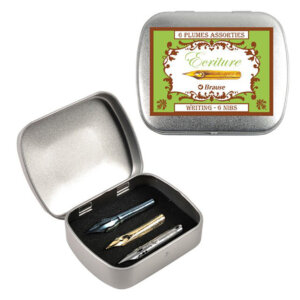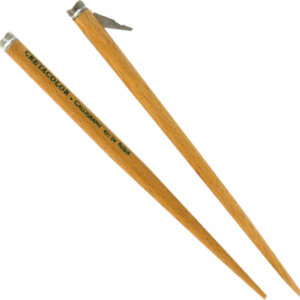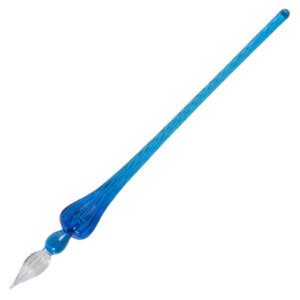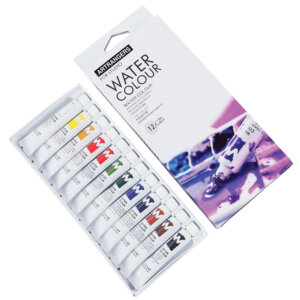Watercolour paint is made up of finely ground pigment suspended in a binder made of distilled water and gum Arabic (a gum that is extracted from 2 species of the acacia tree) together with a humectant. The acacia gum, or gum Arabic, acts as the glue that binds the pigment to the substrate it is applied to once the water has evaporated during the drying process. It slows the movement of the watercolour when applied as a wash, and many artists add more gum Arabic to their watercolour to gain control over their colour, i.e. stop it from bleeding or spreading too quickly over a surface (more on this in the watercolour mediums section). Generally, the character of each watercolour colour tends to rely more heavily on the characteristic of the pigments used, and certainly more so that found in oils of acrylics, where the character of the binder itself plays a more significant role in contributing to the character of the paint overall. This is also true because colour is applied much more thinly, which allows for the characteristic of the pigment to be more apparent in the very thin paint film that is applied.
The 3 main properties of watercolour – transparency/opacity, staining capacity and granulation
Watercolourists tend to consider 3 key characteristics when choosing the pigments that they wish to work with:
The Transparency or Opacity refers to the levels of transparency or opacity within the individual pigments.
Because watercolour is supposed to be applied in a relatively diluted state, it is rare to find watercolour applied so that it appears fully opaque, however, all pigments have their own degree of transparency or opacity which will have some bearing over how they mix with other pigments, and how they appear on the surface when painted with.
Staining refers to how much of the pigment will not lift from the paper after being blotted with a damp sponge; more modern pigments as well as some of the stronger traditional watercolour paints such as Prussian Blue and Alizarin Crimson tend to have a greater staining capacity whereas the older, more traditional pigments tend to lift with relative ease.
Granulation refers to when the pigment particles do not dry with even spacing, and instead they form pools of darker shades of colour when applied to a surface (be it paper or a canvas that has been primed with absorbent ground) – in other words it dries with a grainy appearance. This is caused by the characteristics of the pigments used – some are heavier and cannot be ground to as fine or as uniform a state as others can, and this causes the effect. There can also be a difference between the manner that pigments granulate – a fine pigment such as French Ultramarine will show flocculation – this is when the pigments rush together in huddles. A heavier pigment such as the ones used to make permanent mauve will simply fall into the hollows of the paper surface. The general rule to bear in mind is that while traditional pigments such as the earths, cobalts and ultramarines granulate, the modern colours tend not to. Winsor and Newton’s Granulation Medium can be added to colours to increase their tendency to granulate.
What is Permanence or Lightfastness?
You will find in some watercolour ranges that there will be some pigments that are not classified as lightfast – this means that they will fade if continuously exposed to sunlight. Not all watercolourists make paintings that are intended to be framed and hung on a wall, and because some pigments have a wonderful vibrancy and brilliance despite their poor lightfastness ratings, they are included in some ranges due to the demand. An example of this would be Opera Rose – this vibrant pink is extremely popular among botanical painters in particular, and because some botanical painters keep their work in books and portfolios, its permanence is of lesser importance, and this is why manufacturers such as Winsor & Newton and Sennelier include it in their ranges. If lightfastness is of great importance to you and your work, always consult the manufacturer’s colour chart to make sure the pigments you choose will not fade.
What’s So Important About Single Pigment Colours?
Single pigment colours are easier to mix bright and vibrant colours with as a combination of too many pigments will only ever achieve muddy or dull hues. Some colours can only be made with a combination of pigments – popular colours such as Quinacridone Gold have to be mixed as the original pigment is no longer available, and Permanent Alizarin Crimson is mixed so that there is a lightfast alternative to the traditional single pigment colour. It is a good idea for beginners of watercolour painting to try to avoid using more than 2 or 3 pigments in mixes. It is a really good habit to get into in order to achieve vibrant and colourful looking paintings. Artist and Professional grade watercolours will have a larger proportion of single pigment colours in their ranges, examples of these include Winsor and Newton Artists’ Water Colour, Schmincke Horadam, Holbein Artists’ Watercolour, Daniel Smith Extra Fine Watercolour, Sakura Artists’ Watercolours and MaiMeri Blu Artists’ Watercolours.
Student Watercolour ranges are more affordable because there are less expensive pigments used in the colours, and ‘hue’ colours (mixtures of other pigments) are used to replace expensive cobalt and cadmium colours. Student watercolours are cheaper, and suitable for beginners as well as students and professionals on a budget. Student watercolour ranges are more likely to have lower permanence ratings, but if this is of importance to you it is always worth consulting the colour chart. Student watercolours such as Micador Koh-I-Noor can be mixed with Artist Watercolours.
Ther Lascaux Sirius Primary Watercolour System based on the Munsell System of Colour is a concept in watercolour painting – 5 colours comprising of a warm and a cool red, a warm and cool blue and a yellow (usually lemon as a golden yellow can be mixed) form the whole range. It is the belief of Lascaux Colours that all the colours a watercolour painter might need can be mixed from these 5 tubes of paint. It can easily be argued that the seemingly limited colour range actually allow for greater control, freedom and chances of success, as colours are less likely to muddy and palettes are much more likely to maintain colour harmony. This is often a very good palette for a beginner to adopt as it encourages mixing, however it does not take into account the refractive nature of pigments which is very exciting.
Some colour ranges, such as Sennelier l’Aquarelle, use honey as well as gum Arabic to bind their paints, as the honey, which is a humectant helps to enhance brilliance, luminosity and the longevity of the colours. The consistency of St. Petersburg White Nights Watercolour can vary from colour to colour; this is because there are less controls within their manufacturing processes. The result is that the characteristics of the individual pigments are more apparent, and many artists find it adds dynamism to the working process.
The Difference Between Artist Quality and Student; Choosing A Range
The highest quality watercolour paints are known as Professional colour, and these will have the highest ratio of pigment to binder. The colour will be very intense in the pan or squeezed from the tube, and you will need less of it.
The quality of the binder will also influence the quality of the paint. The binder can also be a question of preference. Sennelier watercolour add honey to the binder as they believe it optimises the consistency of the paint, but some artists prefer the consistency of other professional grade colours that do not use honey – our suggestion is to try and see which brand works for you.
The blending of the pigment tends to be better in professional colours. Pigments will be more finely ground and mixed into the gum Arabic, however over time it is inevitable that all colours, regardless of their quality, will experience the pigments settling into the tube and separating from the binder. If this happens it can be fixed by stirring the paint around in the tube using the end of a paperclip. The structure of the pigment particles has an influence over the degree to which they can be ground, and this in turn affects whether a colour granulates or not. This is not really a reflection of the quality of the paint, just a characteristic of granulating colours. However if a colour appears grainy when it is not supposed to be, such as Neutral Tint, then it is probably because the paint is of a lesser quality and may not be as stable.
Below is a summary stating our most popular brands of watercolour and the differences in their ranges. The professional ranges are listed at the top, artist’s quality in the middle and student grade at the bottom, but in no particular order.
Difference in watercolour brands
Name of Paint Quality Number of Colours Available Available in Unique Selling Point? Other notes
Winsor and Newton Artist’s Watercolour Professional 96 5ml and 14ml tubes, half pans and full pans The 1st moist watercolours ever (since 1832) Regarded very highly, gum Kodorfan is used to bind pigments
Holbein Artist’s Watercolour Professional 118 5ml and 15ml tubes creamy texture paint with excellent handling Manufactured in Japan and is designed with European and Japanese painting styles in mind
Schmincke Horadam Watercolour Professional 110 5ml and 15ml tubes, half pans and full pans 69 single pigment colours Pans are made by pouring thin layers of paint into the pan and allowing drying time between each layer to optimise performance and consistency.
Daniel Smith Watercolour Professional 230 15ml tubes Considered by many to be the best paint in the world!
Maimeri Blu Artist’s Watercolour Professional 72 12ml tubes and half pans Smaller range of colours only uses most transparent and most lightfast colours 52 of the colours are single pigment
Sennelier l’Aquarelle Professional 98 10ml tubes, 21ml tubes, half pans and full pans Produced in the same way for more than a century, l’Aquarelle paints were initially developed with the Impressionist School of painters specifically in mind
Old Holland Classic Watercolours Professional 168 6ml and 18ml tubes, half pans unparallelled colour strength labels on the tubes have a screen printed version of the colour in the tubes as it would appear if applied to paper in a watercolour painting (its undertone)
Winsor and Newton Cotman Watercolour Student 40 8ml and 21 ml tubes, half pans Winsor and Newton are able to keep their costs down by replicating expensive pigments with mixes of alternative pigments (these have the word ‘hue’ after the name)
Reeves Watercolour Sets Student / Children Sets Popular range of first basic watercolour palette sets to inspire young people interested in trying art for the first time. They are good gift ideas for young people.
Different Cultural Origins of Watercolours
There are three main schools of watercolour which are British, European and Asian (China, Japan and Korea). In these notes we will discuss the British and European schools as we have devoted a separate section called ‘Traditional Japanese Watercolours’ which we are particularly fond of at The PaintBox.
Thinking of the cultural aspects of paint making in so far as it pertains to watercolour, it is helpful to think of it as a spectrum (no pun intended! At one end are firms such as Winsor & Newton and Daniel Smith (American I know) whose paints are popular because of their prevalence of transparent pigments and granulation. At the other end of the spectrum is the European School, dominated by Old Holland with Sennelier in the mid ground and Schminke somewhere between Sennelier and Old Holland. These more European paints are very vibrant and often velvety and opaque. An artist who is strongly set on the principles of the far end of the British school might look at the other European end of the spectrum and say “why don’t they just call it gouache? As to which side of the spectrum you find yourself on is an intensely personal matter of preference and we encourage experimentation so that our customers can find exactly which properties in a paint they are compatible with. We also state that we don’t really promote strict brand loyalty, life is full of endless variations as is art and paint!
The Difference Between Pans, Tubes and Sticks
Watercolours are available in tubes, pans and sticks. They are all made of the same ingredients but the differing forms appeal to different kinds of painters. Pans are plastic vessels in which dried watercolour is kept. Colour is taken from a pan by dragging a wet brush over it. Pans are very easy to carry about (in watercolour boxes) and convenient. Large pans are available for those who like to work on a large scale, or use broad brush strokes, for example washes in their work.
Tubes contain wet watercolour, which could be squeezed into empty pans if so desired, or on to a palette. They are great if you want to pre-mix a batch of colour to contain in pans. They are also very good for painters who like to work with very intense colour.
Sticks are dried watercolour in stick form. They can be used like pans, i.e. wet brush to extract the colour from the stick, and they can also be used as a drawing tool, applying colour from the stick straight on to paper, either wet or dry. They are the newest form of watercolour available.
About Watercolour Pencils
Watercolour pencils are coloured watersoluble pencils. They usually contain some wax to keep the leads solid. They can be used as a medium in their own right, or they are also very useful for adding detail to conventional watercolour pencils. They can be used dry as regular coloured pencils, or like pans ( extracting colour using a wet brush), or they can be dipped into water and drawn with, creating very intensely saturated marks. We sell different sorts of watersoluble pencils, the strongest ones are actually Ink Pencils made by Derwent, called InkTense.
A Glossary Of Other Watercolour Related Terms
Mass Tone
The appearance of the colour of the paint as it comes from the tube
Under Tone
Under tone is the bias of a colour when applied across a surface in a thin film , e.g. Ultramarine blue would be said to have a reddish-blue undertone
Colour Strength
Another term used to define colour strength is saturation. Colour strength essentially refers to the ratio of pigment to binder, it is a description of how vibrant/brilliant/clean the colour appears.
Opacity/Transparency
Is the measure of how much light is able to pass through the pigment particles. Opaque colours allow only very small quantities of light through the colour whereas transparent colours allow a lot of light through the colour. The difference is that opaque colours will look flatter and will cover over any marks that may have been made underneath. Transparent colours will show the marks made underneath, and may appear to have more texture. Traditionally watercolour painting is a transparent painting method and conventionally it is the white of the paper being painted on that acts as the white in your work…however it is now common practice for many watercolour painters to use white gouache or Chinese white watercolour in a watercolour painting, often as finishing highlights and touches. White gouache can be tinted with transparent watercolour and used in watercolour painting; it is often referred to as ‘body colour’ due to its opacity.
Blending
the fusing of 2 colour planes with one another in such a way that there are no hard edges. In watercolour this is easily down with a wet brush, dipped in either water or gum Arabic. If watercolour is allowed to thoroughly dry then blending is made a little more difficult – the edges may be harder to lift. In instances such as this a blending medium can be mixed with the colour with will prolong the amount of time that the colour is wet for, and make blending a lot easier.
Dry Brush Technique
When watercolour paint that is relatively dry, and in the least ‘gummy’, is applied with a dry brush to paper. The effect is chalky in appearance, and saturated in colour, and often makes for a dramatic contrast against more delicate, watery, water colour washes. A very effective and dramatic method for creating textured surfaces within water colour painting.
Watercolour Easels
watercolour easels often tilt to allow painters to work flat (preventing washes and large amounts of water from running). However some watercolourists may find that working upright works for their preferred technique.
Flat Wash
The use of a single diluted colour to cover the white of the paper in a relatively unsaturated and uniform manner. Washes are usually applied with a broad brush with natural hair that can hold a lot of fluid, such as a squirrel mop. Painters may choose to work over the wash once the wash is dry, or to work into the wet wash. By doing this one is said to be painting ‘wet on wet’ and the result is that the colours bleed into the layers on to which they have been applied. Flat washes can be applied on to dry or damp paper.
Fugitive Colour
refers to non lightfast paints, such as Opera Rose. They fade, or distort in other ways, when exposed to sunlight. Generally it is advised to stick to colours that have been rated of excellent or very good lightfastness (they may also have the classification of being ‘I’ or ‘II’) if you are intending on exhibiting or displaying work on a wall, as opposed to keeping it in a book or portfolio.
Glazed Wash
A glazed wash is when a dilute colour is applied across the surface of a watercolour painting that has been left to dry completely – the result of doing this is to tint the whole surface with the colour of your wash. Someone who decides to apply a glazed wash over a work would therefore have to consider the influence the chosen glaze hue would have over the colours that have been worked with previously. Once dry the artist has the option to work over the top once more.
Gum Arabic
a gum that is extracted from 2 species of the acacia tree, which is used as a binder in the manufacture of watercolour paint. Can also be purchased separately – it increases transparency and gloss.
Masking Fluid
Masking fluid is sometimes known as liquid frisket and is used to mask off areas of your work. It is painted on like tippex (you can apply it using a brush, a ruling pen, a colour shaper, or anything else!) and once dry you can then work in watercolour over the top. A good example of when masking fluid may come in handy is if you are applying colour on to a painting of a leaf, but you wish to keep the veins white – you would then paint the veins on with the masking fluid, allow it to dry and then apply your colour over the top. Providing the masking fluid is applied in dry paper and is left to dry completely before working over the top, (and the watercolour applied over the top is also left to dry completely!) the masking fluid should peel off with relative ease, just coax off a corner with a colour shaper or the end of your brush and the rest should come off by pulling it with your fingers. If it feels as if it is very stuck a handy little tip is to roll up a ball of dried masking fluid between your finger and thumb and use this to coax the masking fluid off – the stickiness works wonders!





